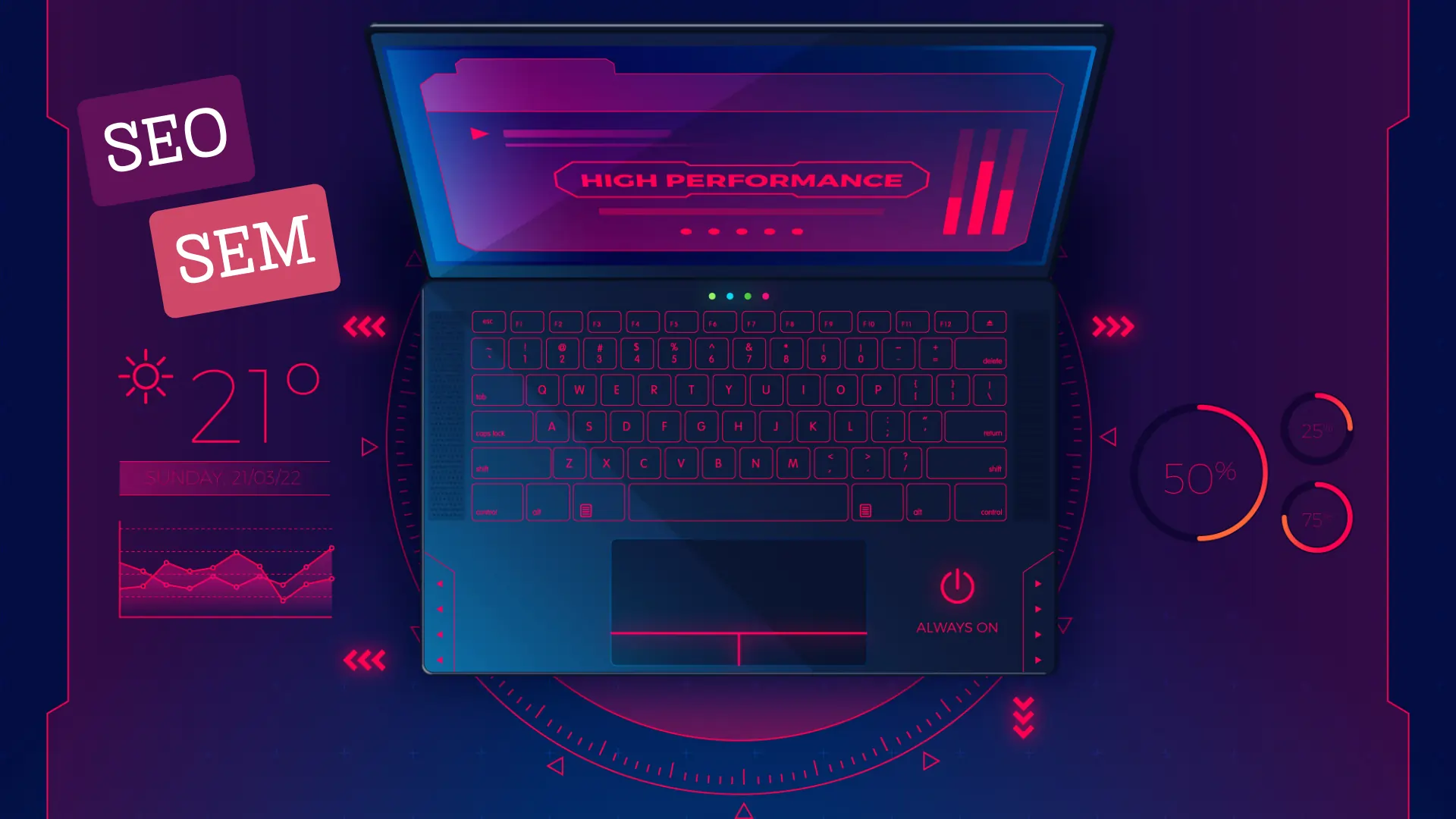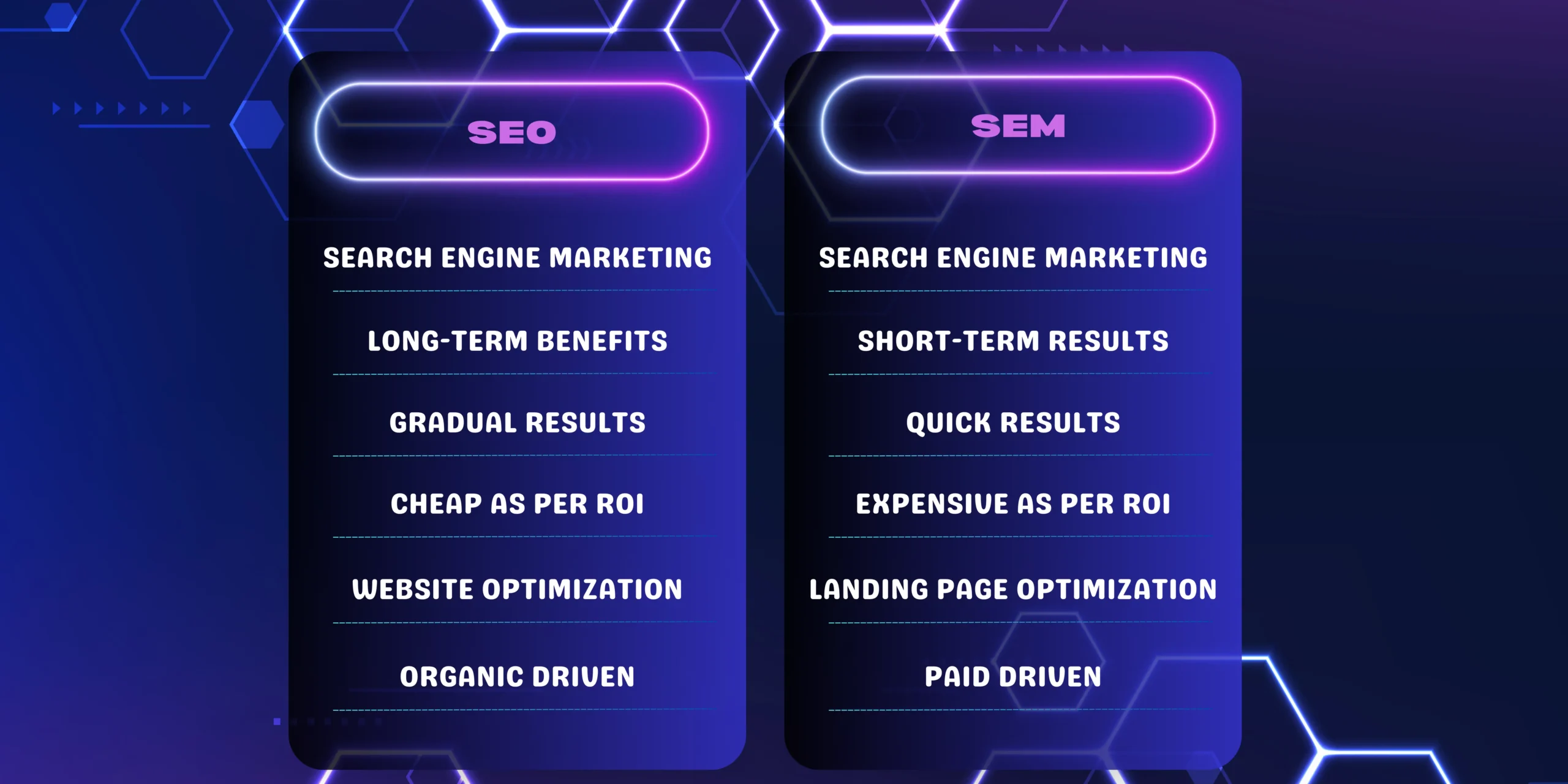SEO vs SEM. What's the difference and Which is better?

SEO vs SEM
Introduction:
In the dynamic landscape of Digital Marketing, two key strategies stand out: Search Engine Optimization (SEO) and Search Engine Marketing (SEM). Both play crucial roles in enhancing online visibility and driving traffic to your website.
Let’s delve into the differences between SEO and SEM and explore when each strategy is more advantageous.
1. Definition
SEO (Search Engine Optimization): SEO is a long-term strategy focused on optimizing your website’s content, structure, and backlinks to improve its visibility in organic (unpaid) search engine results.
Let’s delve a bit deeper into Search Engine Optimization:
a) Content Optimization:
– SEO begins with optimizing the content on your website. This involves strategic placement of relevant keywords in titles, headers, meta descriptions, and throughout the body of the content.
– Quality and relevance are paramount. Search engines prioritize content that provides value to users, answering their queries effectively.
b) Technical SEO:
– Technical aspects ensure search engines can crawl and index your site efficiently. This includes optimizing site speed, improving mobile responsiveness, and creating a logical site structure.
– Sitemaps, robots.txt files, and proper URL structures are essential components of technical SEO.
c) Backlink Building:
– Backlinks are like digital votes of confidence. SEO involves building a strong backlink profile by acquiring links from reputable and relevant websites.
– High-quality backlinks indicate to search engines that your content is authoritative and valuable.
d) User Experience:
-A positive user experience is crucial for SEO. This includes easy navigation, clear calls to action, and a visually appealing design.
-Search engines aim to provide users with the best possible results, so a user-friendly website is more likely to rank higher.
e) Analytics and Monitoring:
-SEO is an ongoing process that requires constant monitoring and adaptation. Utilize analytics tools such as Google Analytics to track key metrics like organic traffic, bounce rates, and conversion rates.
-Regular audits help identify and address any issues that might impact your site’s performance in search results.
f) On Page SEO:
-On-page SEO involves enhancing individual web pages to boost their search engine rankings and attract increased organic traffic. This optimization includes refining elements like content, HTML source code, and site structure to enhance relevance and appeal to users and search engines.
-In digital marketing, On-page SEO is pivotal, influencing a website’s visibility, credibility, and overall effectiveness in generating targeted traffic and conversions.
SEM (Search Engine Marketing): SEM, on the other hand, encompasses a broader range of activities, including paid advertising on search engines. This often involves Pay-Per-Click (PPC) campaigns, where advertisers bid on keywords to have their ads displayed in the sponsored section of search engine results.
a) Paid Advertising (PPC):
– SEM involves paid advertising to increase a website’s visibility in search engine results. The most common form is Pay-Per-Click (PPC) campaigns, where advertisers bid on specific keywords.
– Ads are displayed prominently in the sponsored section of search results, and advertisers pay when users click on their ads.
b) Keyword Research for PPC:
– Identifying the right keywords is crucial for PPC success. Advertisers bid on keywords relevant to their products or services.
– Extensive keyword research helps understand the competition, estimated costs per click, and the potential return on investment.
c) Ad Copy Creation:
– Crafting compelling ad copies is essential. Advertisers need to convey their message concisely and encourage users to click on the ad.
– A/B testing is often employed to refine ad copies and improve their effectiveness over time.
d) Landing Page Optimization:
– Once users click on an ad, they are directed to a landing page. Optimizing this page for conversions is crucial for SEM success.
– A well-designed and relevant landing page improves the user experience and increases the likelihood of achieving the desired outcome, whether it’s a sale, lead, or sign-up.
e) Campaign Monitoring and Adjustments:
– Constant monitoring of PPC campaigns is necessary. Advertisers need to track performance metrics, adjust bids, and refine targeting to maximize the effectiveness of their campaigns.
– SEM allows for real-time adjustments, enabling advertisers to respond quickly to changes in the competitive landscape or shifts in user behavior.
2. Timeframe and Results
SEO: It is a gradual process that requires time to see significant results. The impact of SEO efforts may take several months to become apparent, but the long-term benefits can be substantial.
SEM: SEM provides more immediate results, making it a powerful tool for businesses seeking quick visibility. As soon as you launch a PPC campaign, your ads can start appearing in search results, driving traffic almost instantly.
3. Cost
SEO: Generally, the cost of SEO is lower in the long run compared to SEM. While there are upfront costs associated with optimizing a website, ongoing maintenance and content creation are the primary expenses.
SEM: SEM involves direct costs, as you pay for each click on your ads. The budget for SEM campaigns can vary, and it’s important to monitor and adjust your spending to optimize the return on investment.
4. Organic vs. Paid
SEO: Focuses on optimizing your website to appear in organic search results. Users are more likely to trust organic listings, as they perceive them as more authentic and relevant.
SEM: Involves paid advertisements, which are displayed prominently at the top of search results. While these ads can quickly boost visibility, users may be aware that they are sponsored and might be more skeptical.
5. Keyword Strategy
SEO: Relies on comprehensive keyword research to optimize On-page content and meta tags. The goal is to rank for relevant keywords organically.
SEM: Involves bidding on specific keywords to display ads. The effectiveness of SEM campaigns heavily depends on selecting the right keywords and managing bids strategically.
Conclusion
In essence, SEO and SEM are complementary strategies that, when used together, can enhance a website’s visibility and performance in search engine results. SEO lays the foundation for long-term organic growth, while SEM provides agility and immediate visibility through paid advertising. The key is to integrate these strategies seamlessly, aligning them with your business goals and target audience to achieve a comprehensive and effective online presence.

Thanks For Reading: SEO vs SEM: What’s the difference and which is better?
Partnered With Naumaan Oman
Recent Posts
Working Together Ideas come to life
No matter how big your company is, as you expand and reach new highs you’ll want an agency to have your back. One with a process
360presence@gmail.com

© 2023 360PRESENCE All rights Reserved
















